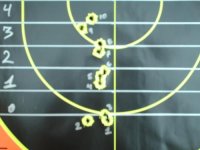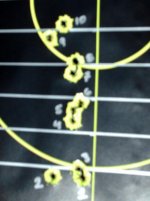Mike,
You're not understanding OCW. If you believe the ladder test can work (and it of course can), then you're looking for the same three charge increments with OCW--you're just more likely to find the true sweet spot with OCW than with ladder.
The round robin firing sequence of OCW factors out the effects of a fouling and heating barrel, whereas the ladder test disadvantages (or sometimes advantages) the same charge weight range because that particular range is always being fired through a barrel in the same condition of foul and temperature. OCW negates this by plotting shots on the target from the same charge weight but in varied bore conditions. This is of vital importance to the resilience of any load recipe--it must perform the same from a perfectly clean, cool barrel as it does from a fouled and/or warm barrel. .
A perfectly executed ladder test where no false leads enter the string will lead you to the same charge weight OCW will lead you to.
It's just that with OCW, you're factoring out the error potential to a much greater degree than you have with a standard ladder--and you're more likely to arrive at the optimal charge weight.
There is absolutely no difference in the seeking of the best hunting load as opposed to the best BR load--we're always after the highest accuracy potential available.
I'm not sure what you think OCW is, but you're obviously mistaken as to its method and goal.
Edit to add: You mention that my OCW method starts with 36 rounds and 7 targets. It doesn't. Generally, it's only 5 targets and less than 20 rounds. I think someone has given you bad information about OCW...
Dan



